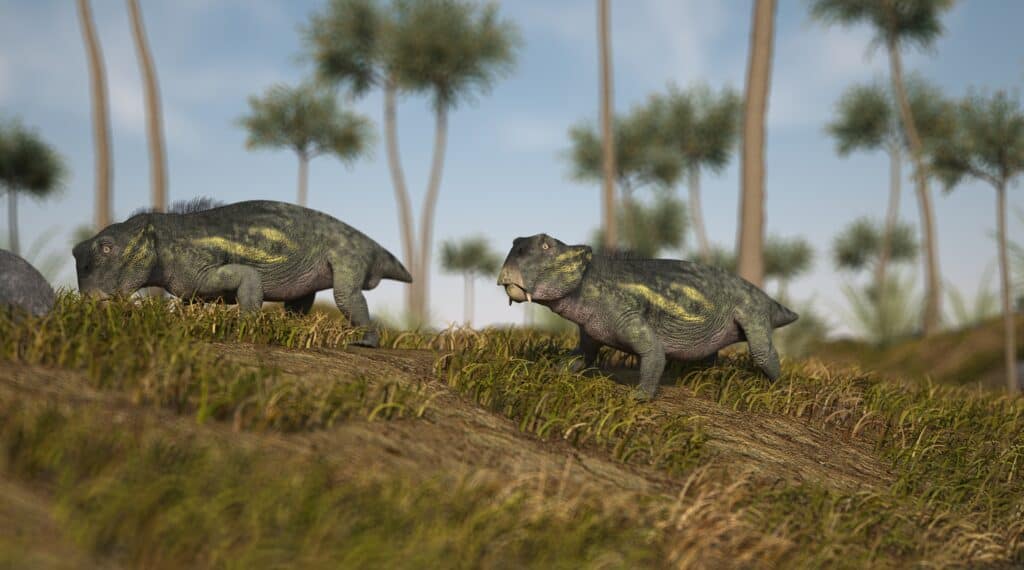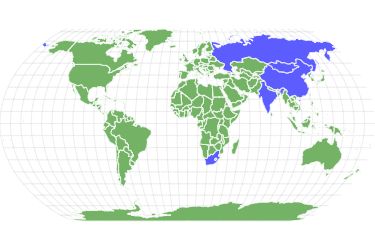Lystrosaurus
Lystrosaurus maccaigi
Lystrosaurus was one of the few terrestial species that survived the permian extinction
Advertisement
Lystrosaurus Scientific Classification
- Kingdom
- Animalia
- Phylum
- Chordata
- Family
- Lystrosauridae
- Genus
- Lystrosaurus
- Scientific Name
- Lystrosaurus maccaigi
Read our Complete Guide to Classification of Animals.
Lystrosaurus Conservation Status
Lystrosaurus Facts
- Fun Fact
- Lystrosaurus was one of the few terrestial species that survived the permian extinction
- Biggest Threat
- Shortage of food sources in the Triassic
- Most Distinctive Feature
- Tusk-like upper canines
- Distinctive Feature
- Curved snout with nostrils at the top
- Predators
- Moschorhinus and Proterosuchus
- Diet
- Herbivore
- Favorite Food
- Dicroidium
- Special Features
- They had nostrils at the top of their upward curving snout which probably assisted with breathing.
- Number Of Species
- 4
Lystrosaurus Physical Characteristics
- Weight
- 100-200 pounds
- Length
- 3-9.8 feet
- Venomous
- No
- Aggression
- Low
View all of the Lystrosaurus images!
Lystrosaurus is one of the few terrestrial animals that survived one of the most significant extinction events in geologic history—the Permian-Triassic extinction. The animal was a pig-sized reptile that lived over 250 million years ago. At one point in the Early Triassic, it made up 95% of land vertebrates. Lystrosaurus fossil discovery became critical evidence for continental drift and land bridging.
Description and Size
Lystrosaurus is an extinct genus of dicynodont therapsids from the Early Triassic and Late Permian periods. The name is from the Greek words “listron sauros,” meaning “shovel lizard.” Lystrosaurus measured 3–8 feet in length and weighed about 200 pounds. That is about the size of an average pig.
Lystrosaurus also had a sort of pig-like appearance; It had a short snout. However, the only teeth present were two tusk-like upper canines. They also had horny beaks similar to those of turtles for shearing off vegetation. The animal had dorsally located eye orbits, and its two tusks were set deeply in the upper jaw. Wears on the tusks indicate Lystrosaurus used them for digging and rooting out vegetation.
The jaw joint was weak and moved in upward and backward motions during a shearing action instead of the usual up and down or sideways movement. The lower jaw could also slide forward and backwards, enabling Lystrosaurus to move vegetation easily into its mouth. The animal’s nostrils were high up on its curved snout, allowing it to feed in shallow waters or marsh and swamp habitats.
Lystrosaurus also had a spreading posture and a short tail. There were five toes on each of its feet, and the front legs had large bones bigger than its rear ones. Like most tetrapods, Lystrosaurus walked around on all four feet, with their legs slightly splayed out to the sides like alligators’ legs. Their five sacral vertebrae were massive but not fused to each other or the pelvis. As a result, the back was rigid. Paleontologists believe Lystrosaurus was a powerful digger and burrower.
Bone histology suggests that Lystrosaurus was a fast-growing animal. Mummified specimens from the Karoo Basin revealed that Lystrosaurus had dimpled, leathery, and hairless skin.

had a sort of pig-like appearance, with a short snout and no teeth.
©Kostiantyn Ivanyshen/Shutterstock.com
Diet—What Did Lystrosaurus Eat?
Lystrosaurus was an herbivore. The animal did not have teeth in the usual sense. Instead, it had two tusks that projected downwards from the maxilla for digging up the roots of plants. Apart from this, Lystrosaurus had horny beaks for shearing and snipping off vegetation above ground and used a horny second palate in their mouth to ground the vegetation.
Since they lived in different ecosystems across a wide range of geographical locations, Lystrosaurus was adapted to eating different types of plants. Many species ate Dicroidium, an extinct genus of fork-leaved ferns that were abundant during the Permian and Triassic. Larger species, such as the Lystrosaurus maccaigi, probably evolved to rely on larger plants of the period, such as the Glossopteris flora. Unfortunately, this plant did not survive the Permian extinction.
Habitat—When and Where Did Lystrosaurus Live?
Lystrosaurus was widespread across southern continents, with a concentration of remains found in South Africa. Other specimens have been recovered from Russia, India, Mongolia, China, and Antarctica. Lystrosaurus lived in the Late Permian and Early Triassic periods, around 250 million years ago. Their fossil representation is also one of the most common fossil species dating from the Early Triassic.
Threats and Predators
Lystrosaurus had no threats and predators post the Permian–Triassic extinction. Also referred to as the Great Dying, the extinction event wiped out nearly 95% of all species on earth (including a few species of the Lystrosaurus genus). However, at least one unidentified species survived the mass extinction. Only the 5-foot-long Moschorhinus and the large Proterosuchus were big enough to prey on the Lystrosaurus species that lived into the Triassic.
The absence of predators and herbivore competition for the available food allowed Lystrosaurus to thrive without restraint. So much so that for a while, 95% of land vertebrates were Lystrosaurus, becoming the most common group of terrestrial vertebrates during the Early Triassic.
Discoveries and Fossils
Dr. Elias Root Beadle, an avid fossil collector and a Philadelphia missionary, discovered the first Lystrosaurus skull. He wrote to paleontologist Othniel Charles Marsh about his discovery but received no reply. However, Edward Drinker Cope, who was Marsh’s major rival, showed interest in the find and named Lystrosaurus in 1870.
Most Lystrosaurus fossils were found in the Balfour and Katberg Formations of the Karoo Basin in South Africa. Although the initial estimate of discovered fossil species was 23 between the 1930s and 1970s, further studies in the 1990s recognized only six species. They include L. curvatus, L. declivis, L. platyceps, , L. maccaigi, L. oviceps and L. murrayi. Another study in 2006 downsized the list to four, merging fossils previously labeled as L. platyceps and L. oviceps as members of L. curvatus. Lystrosaurus maccaigi was the largest and most specialized species found only in sediments from the Permian Period. The species did not survive the Permian–Triassic extinction event.
On the other hand, L. curvatus was the least specialized and was found in a relatively narrow band of sediments from shortly before and after the extinction. A skull fragment subsequently identified as L. curvatus was discovered in Late Permian sediments in Zambia. For years, scientists believed L. curvatus did not live in the Karoo during the Permian, which led many to suggest they migrated from Zambia into the Karoo. However, a re-examination of the Karoo specimens identified some as L. curvatus.
Extinction—When Did Lystrosaurus Die Out?
The Permian-Triassic extinction, also known as the Great Dying, wiped out a few Lystrosaurus species about 250 million years ago. However, some species did survive the extinction. Although some scientists have attributed their survival to luck, there are still speculations on how they survived the mother of all mass extinctions. Growth marks observed in some fossil tusks suggest that the Lystrosaurus species that lived in Antarctica could enter a state of prolonged sleep similar to hibernation. Apart from this, their burrowing lifestyle could have helped them survive in an atmosphere of stale air that made it difficult for most terrestrial species to breathe. Lystrosaurus species that survived the extinction event became the ancestor of many later dicynodonts like Placerias.
Similar Animals to the Lystrosaurus
Similar animals to the Lystrosaurus include:
- Dimetrodon — Dimetrodon lived during the Early Permian, around 295–272 million years ago. Often mistaken for a dinosaur, Dimetrodon was a quadrupedal, sail-backed synapsid that weighed between 60-550 pounds.
- Cynodont — Cynodont is another extinct group of animals that evolved in the Late Permian Period and diversified further after the Permian–Triassic extinction event. Cynodonts are the ancestors of modern-day mammals. However, the cynodonts themselves went extinct during the Cretaceous Period.
- Placerias — Placerias was one of the largest herbivores of the late Triassic. They weighed up to 2,400 pounds, and there are possible ecological and evolutionary parallels with the modern hippopotamus.
Related Animals
View all 98 animals that start with LLystrosaurus FAQs (Frequently Asked Questions)
When was Lystrosaurus alive?
Lystrosaurus was alive 250 million years ago. It lived through the Late Permian and Early Triassic periods.
How big was Lystrosaurus?
An adult Lystrosaurus was about 3–8 feet long and weighed up to 200 pounds.
What did a Lystrosaurus eat?
Lystrosaurus was a herbivore that ate small plant life. Although it was not high on the food chain, it thrived largely due to the absence of predators after the Permian–Triassic extinction.
Thank you for reading! Have some feedback for us? Contact the AZ Animals editorial team.
Sources
- Wikipedia (1970) en.wikipedia.org/wiki/Lystrosaurus
- Fossil Fandom (1970) fossil.fandom.com/wiki/Lystrosaurus
- Study.com (1970) study.com/academy/lesson/lystrosaurus-facts-lesson-quiz.html
- Britannica (1970) britannica.com/animal/Lystrosaurus
- National Geographic (1970) nationalgeographic.com/science/article/lystrosaurus-the-most-humble-badass-of-the-triassic

















